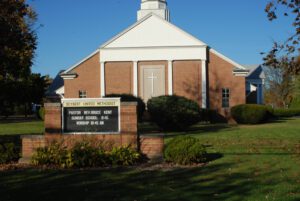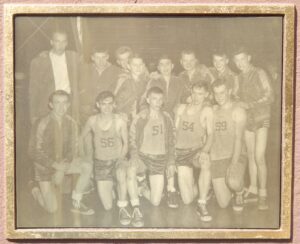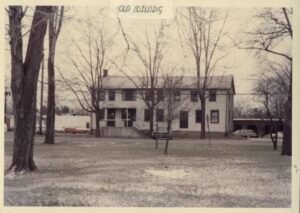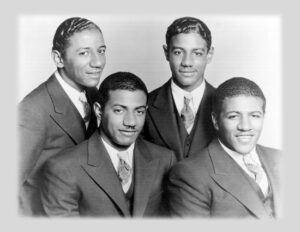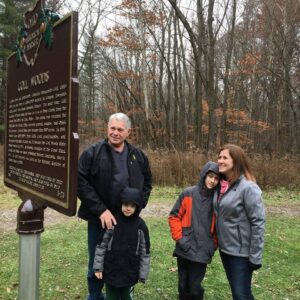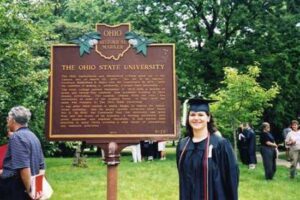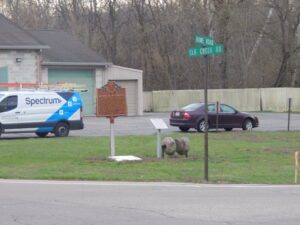, OH
Born in Pennsylvania in 1791, Bishop John Seybert came to Ohio in 1822 and preached throughout the mid-west. Seybert served the faith for forty years as an itinerant preacher, a presiding elder, and the first bishop of the Evangelical Association, one of the original denominations that is now part of the United Methodist Church. As a circuit rider, he traveled on foot, horseback, and spring wagon a distance of 175,000 miles, preached 9,850 sermons, held 8,000 prayer and class meetings, and made about 46,000 pastoral calls and 10,000 calls on the sick. Seybert often paid his own expenses on the meager salary of $100 per year. He died in 1860 and is buried in the Bellevue – Flat Rock area.
, OH
Team photograph here Standing, L to R: Coach C. Norris Simpson, Donald Alt, Bill Ziegler, Roy Meyer, Jerry Kuhlman, Karl Inkrott, Vern Schroeder, Mel Lammers Kneeling, L to R: Joe Lammers, Junior McDonald, Frank Schroeder, Ralph (Skip) Meyer, Dick Barlage Team manager: Charles Warnimont Cheerleaders: Betty Lou Meyer, Agnes Riepenhoff, Clara Schroeder, Audrey Wischmeyer School colors: Blue and Gold “You have got to have the boys and I had the boys” –Coach C. Norris Simpson
, OH
In the heyday of steamboating on the Muskingum, many people made their livelihood on the river. Jane McMillan, known as Old Jane, was one of the few women reported to have piloted boats on the river. In the 1840s she was co-owner of the “Zanesville Packet.” McMillan worked a variety of jobs, from cook to pilot. She was reported to know the twists and turns of the river so well that she could navigate safely at night, something many pilots refused to do. Isaac Newton Hook, a descendant of the earliest settlers in Zanesville, used skills he learned on the Muskingum River as a pilot on the Mississippi during the Civil War. He shipped supplies needed by the Union army. His tomb is in the Brick Church cemetery between Hooksburg and Stockport. He had the grave built out of concrete and above the level of the 1898 flood. The 1913 flood submerged the tomb, but it survived and can be viewed to this day.
, OH
The Independent Order of Odd Fellows (IOOF) traces its origins to mid-18th-century England, where it served as a mutual benefit society for traveling workmen. Odd Fellowship moved to the United States in 1819; the first Ohio lodge was established in 1830, and the Canfield Lodge was instituted in 1850. The charter members of this lodge were E.J. Estep, John G. Kyle, James Powers, W. M. Prentice, and William W. Whittlesey. Many of the early members of this lodge were businessmen, lawyers, physicians, and tradesmen. Lodge 155 remains one of the oldest active lodges in northeastern Ohio. (continued on other side)
, OH
Born in Piqua, Ohio, the Mills Brothers grew up and attended school in Bellefontaine. The brothers — John, Jr., Herbert, Harry, and Donald Mills — were the first African-American vocal group to perform on a national radio broadcast and achieve commercial success. Enjoying worldwide fame throughout their career, the Mills Brothers popularized such hits as “Tiger Rag,” “Paper Doll,” and “You Always Hurt the One You Love.” After the death of John, Jr. in 1936, the remaining brothers were joined by their father, John, Sr. In all, the Mills Brothers recorded over 1,200 songs.
, OH
Two Deputy U.S. General Land Office Surveyors traversed Goll Woods: Benjamin Hough in 1815 and Captain James Riley in 1821. Hough (1772-1819) established the Michigan Meridian in 1815 and was county and state office holder in Ohio. Riley’s life was more tumultuous. Riley (1777-1840) captained the merchant ship Commerce, which wrecked off the Saharan coast in 1815. Riley and crew were enslaved for four months until ransomed by British diplomat William Willshire. In 1817, Riley published a famous account of his time in North Africa, and, in 1819, was appointed a surveyor by Surveyor General Edward Tiffin. Moving to Northwest Ohio, Riley named the village he founded in 1822, Willshire, for his deliverer. Riley returned to New York in 1826 and to the sea, where he died. Riley’s book went through more than twenty editions by 1860 and Abraham Lincoln credited the account as one that influenced him deeply.
, OH
The Ohio Agricultural and Mechanical College grew out of the Cannon Act of March 22, 1870. “But let it be started,” Governor Rutherford B. Hayes told the Legislature in 1873, “with the intention of making it a great State University.” The little college opened September 17, 1873 with a faculty of seven and twenty-four students. One academic building at first housed everything. The campus, remote from the city, was surrounded by some of the original forest. In May, 1878 the name was changed to The Ohio State University. It was after 1900 before it really began to realize its educational potential, and its major growth occurred after World War II. By 1970, the Centennial Year, the university had more then met the hopes of its founders. A leading university with great manpower and physical resources, it had earned high standing in many fields covering a wide range of educational and research activities.
, OH
The village of Miltonville, located along the banks of Elk Creek, was platted in 1816 by George Bennett, Theophilus Eaglesfield, and Richard V. V. Crane. The creek served two grist mills, one built around 1804 and operated by a free black, Bambo Harris, and the second was built by George Bennett in 1815. An Indian burial ground was located on the east bank of Elk Creek near the site of Huff’s Ferry. Eagle Tavern, the area’s first three-story brick inn, was a stopover for stagecoach lines traveling the Miltonville-Trenton Turnpike. The village was known for pottery factories, vineyards and wineries, and Frisch’s brickyard, established in 1880. The United Brethren Church, organized in 1811, and Miltonville Cemetery were the sites of church conferences and celebrations. The Miltonville School operated from the 1800s to 1936, and the local post office was in service during the years 1889-1904.


